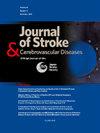Outcomes of Grade 3 Carotid Dissections: A 7-Year Retrospective Analysis of Stroke, Stenosis, and Pseudoaneurysm Progression
IF 2
4区 医学
Q3 NEUROSCIENCES
Journal of Stroke & Cerebrovascular Diseases
Pub Date : 2025-04-23
DOI:10.1016/j.jstrokecerebrovasdis.2025.108307
引用次数: 0
Abstract
Background
Grade 3 blunt cerebrovascular injuries (BCVIs), also known as pseudoaneurysms, are characterized by arterial wall injury forming a sac-like structure, which can sometimes be associated with stenosis and poses a substantial risk of ischemic stroke. This study evaluates the outcomes of traumatic Grade 3 internal carotid artery injuries treated at a single institution.
Methods
A retrospective cohort study was conducted on 33 patients with Grade 3 carotid dissections treated between 2015 and 2022. Primary outcomes included stenosis progression, pseudoaneurysm status, and stroke occurrence.
Results
At final imaging, 90.9 % of stenoses had resolved or improved, while 9.1 % remained unchanged or worsened. For pseudoaneurysms, 61 % had resolved or improved, while 39 % remained stable or worsened. Two patients (6.1 %) experienced strokes despite antiplatelet therapy, with one occurring early and one delayed. The majority (84.8 %) received conservative medical management, with only 9.1 % undergoing endovascular treatment.
Conclusion
Grade 3 carotid dissections have variable outcomes, with most improving or resolving. However, the persistent risk of stroke and pseudoaneurysm progression emphasizes the need for vigilant long-term monitoring and reconsideration of optimal management strategies, particularly regarding the role of antiplatelet therapy and endovascular intervention.
3级颈动脉夹层的预后:卒中、狭窄和假性动脉瘤进展的7年回顾性分析
3级钝性脑血管损伤(BCVIs),也称为假性动脉瘤,其特征是动脉壁损伤形成囊状结构,有时可能与狭窄相关,并具有缺血性卒中的重大风险。本研究评估了在单一机构治疗的外伤性3级颈内动脉损伤的结果。方法对2015 - 2022年收治的33例颈动脉三级夹层患者进行回顾性队列研究。主要结局包括狭窄进展、假性动脉瘤状态和卒中发生。结果在终末影像学检查中,90.9%的狭窄缓解或改善,9.1%的狭窄维持不变或恶化。假性动脉瘤61%消退或改善,39%保持稳定或恶化。2例患者(6.1%)尽管接受抗血小板治疗仍发生中风,1例发生早发,1例延迟发生。大多数(84.8%)接受了保守治疗,只有9.1%接受了血管内治疗。结论3级颈动脉夹层有不同的结局,大多数改善或缓解。然而,卒中和假性动脉瘤进展的持续风险强调需要警惕长期监测和重新考虑最佳管理策略,特别是关于抗血小板治疗和血管内干预的作用。
本文章由计算机程序翻译,如有差异,请以英文原文为准。
求助全文
约1分钟内获得全文
求助全文
来源期刊

Journal of Stroke & Cerebrovascular Diseases
Medicine-Surgery
CiteScore
5.00
自引率
4.00%
发文量
583
审稿时长
62 days
期刊介绍:
The Journal of Stroke & Cerebrovascular Diseases publishes original papers on basic and clinical science related to the fields of stroke and cerebrovascular diseases. The Journal also features review articles, controversies, methods and technical notes, selected case reports and other original articles of special nature. Its editorial mission is to focus on prevention and repair of cerebrovascular disease. Clinical papers emphasize medical and surgical aspects of stroke, clinical trials and design, epidemiology, stroke care delivery systems and outcomes, imaging sciences and rehabilitation of stroke. The Journal will be of special interest to specialists involved in caring for patients with cerebrovascular disease, including neurologists, neurosurgeons and cardiologists.
 求助内容:
求助内容: 应助结果提醒方式:
应助结果提醒方式:


